Learn to Bake: A Beginner’s Guide

Starting to bake is like making art with your food. It turns your kitchen into a magical place. If you want to learn to bake, imagine the smell of bread right out of the oven. Imagine making your own tasty treats! Don’t worry about how to start. This baking guide for beginners will make things easy and fun.
Baking can be like magic. Flour and water become fresh bread. Simple ingredients turn into yummy desserts. We’ll teach you the basics, from scones to soufflés. You’ll learn to bake your dreams with help from pros and great advice. So, grab your apron, warm up the oven, and get ready for a fun baking adventure!
Key Takeaways
- Understanding different types of flour and when to use them.
- The role of leavening agents and how they affect your baked goods.
- The importance of precise measurement in baking for consistent results.
- Essential baking tools that every beginner should have in their kitchen.
- Basic baking techniques to elevate your baking game.
- The power of practice in mastering baking skills.
- Simple and affordable baking tips to begin your home baking journey.
Why Baking is a Valuable Skill
Baking at home is more than just taste and smell. It’s a skill that can improve your health and save money. Knowing the benefits of baking can change your life for the better.
Health Benefits of Home Baking
When you bake at home, you choose what goes into your food. Store foods often have preservatives and artificial stuff. Baking at home lets you use healthy ingredients and cuts down on bad chemicals. Plus, baking can relax you and spark creativity.
Economic Advantages of Baking at Home
Baking at home can also save you money. Starting may cost a bit, but it’s cheaper than buying from stores in the long run. You can make lots of bread and treats for less money.
Regular baking at home boosts skills like being exact, patient, and creative. These skills help in the kitchen and in life. They’re key for doing well in the baking world.
| Key Skill in Baking | Importance (%) |
|---|---|
| Precision in measurements and temperatures | 95 |
| Creativity in flavors and textures | 75 |
| Patience for processes like dough rising | 90 |
| Effective communication among team members | 80 |
| Organization (mise en place) | 100 |
Baking brings health and money benefits. Stepping into baking at home is rewarding. It’s more than making tasty food—it’s about self-care and growth.
Essential Baking Equipment for Beginners
Beginning your baking journey means getting the right tools. From your first cookies to fancy cakes, you’ll need basic items. These tools make baking easier and more fun for new bakers.
Must-Have Baking Tools
Some baking tools are key for starters. A strong hand mixer is needed. The Cuisinart Cordless Power hand mixer at $70.92 is good because it has no cord. Add strong mixing bowls like the Joseph Joseph nest 9-plus at $60, and you’re ready to mix anything.

Getting your measurements right is super important in baking. You’ll need a good set of measuring cups and spoons. The JosephJoseph eight-piece nest measuring cup set at £12 helps with exact ingredient amounts. The ProCook double walled stainless steel sieve, for £8.95, is perfect for sifting.
Optional Gadgets You Might Consider
Some gadgets are not needed but are nice to have. The Ninja Food Processor with Auto-IQ, at £100, is great for difficult recipes. The Jean Patrique digital kitchen scales, at £17.09, give you precise measurements.
A scraper tool makes dealing with dough easy. The PME plain edge side scraper at £5.97 is a good choice. Quality parchment paper, like the ProWrap roll at £7.30, helps with non-stick baking and easy cleanup.
Getting beginner baking tools means choosing both essential and nice-to-have items. This approach prepares you for many recipes and methods. Remember, the right equipment can make baking easier and help your creations succeed.
Understanding Ingredients in Baking
Starting your baking journey means learning about baking ingredients. You’ll find out how they work in recipes. This knowledge can make your baking super good, like what you find in a bakery.
Common Baking Ingredients Defined
Every baking recipe has a list of ingredients that are very important. Flour gives structure. It’s best to use reliable flour like King Arthur. Sugar and vanilla make everything taste and look better.
Eggs and milk add moisture and hold everything together. Fats like butter and canola oil make baked goods soft and tasty. Leavening agents, such as yeast and baking powder, help things rise.
How Ingredients Impact Your Recipes
The impact of ingredients on baking is big. It changes how things feel, look, and taste. The temperature of butter matters a lot. Cold butter can mess up rising.
Ingredients like eggs should be warm to mix well. This makes cakes and bread soft. Knowing this helps you change recipes to make them yours. Switching sour cream for Greek yogurt changes flavor and texture a bit.
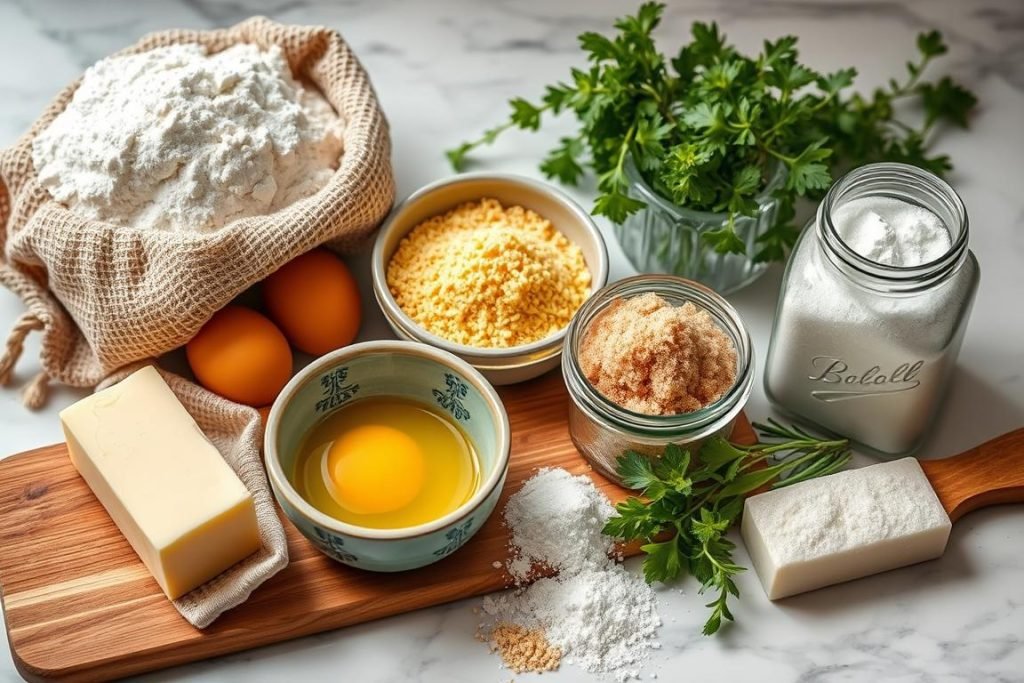
Knowing about ingredients means you can try complicated recipes. Every ingredient, from sugar to yeast, has a special role. This understanding helps make tasty treats that also look great.
Choosing the Right Recipes for Beginners
If you’re new to baking, picking the right beginner baking recipes is key. Starting with easy baking recipes helps you get confident. It also lays the groundwork for more advanced projects.
Simple Recipes to Start With
Starting simple can make learning to bake much easier. Choose recipes that use easy-to-find ingredients and basic equipment. This leads to faster learning and less stress. Try making vanilla cupcakes, basic cookies, or classic muffins. These are easy and fun to make.
Tips for Recipe Selection
Choosing the right recipes means looking at how hard they are and what they require. Pick recipes that don’t need special skills or tools. Here are some tips for picking good beginner recipes:
- Ingredient Accessibility: Go for recipes with ingredients you can easily find or you already have.
- Required Tools: Choose recipes that need only simple kitchen tools. This saves money.
- Preparation Time: Start with recipes that don’t take long to make. This keeps baking fun.
- Likelihood of Success: Choose recipes known to work well for beginners.
Baking is about the joy of making and eating. By starting with easy beginner baking recipes and following these recipe selection tips, you’re on your way to a great baking adventure.
Mastering Basic Baking Techniques
Starting to bake? You’ll need to know the basic steps and be precise. Whether it’s cookies or a complex cake, knowing the basics improves your results.
Mixing Methods Explained
The way you mix ingredients matters a lot. Each method changes how your baked goods feel and rise. For example, mixing butter and sugar until fluffy adds air. This makes cakes and cookies light.
Mixing wet and dry ingredients separately before combining them keeps muffins soft. Folding techniques are key, especially with whipped cream or egg whites. This step is vital for light mousses and sponge cakes.
How to Measure Ingredients Accurately
Baking needs precision, especially when measuring ingredients. Use the right tools to get measurements right. For dry stuff like flour, use measuring cups. For liquids, use cups meant for liquids so you can see the level clearly.
A kitchen scale is super helpful for ingredients like flour. Weighing prevents cakes from being too heavy or cookies from drying out.
Mastering baking techniques and mixing methods makes your baked goods better. It also makes you more confident in the kitchen. Every detail, from mixing to measuring, matters.

See each baking challenge as a chance to learn and improve. Mastering the basics helps you in your baking, leading to more success and creativity.
The Importance of Baking Measurements
For great baking, precise measurements are key. It helps, whether you’re experienced or a newbie. Knowing the difference between volume vs. weight and using tools like a kitchen scale makes baking better.
Understanding Volume vs. Weight
Choosing between volume or weight for measuring can be tricky. Volume uses cups or spoons, commonly found at home. But, this method can cause inconsistencies because ingredients vary in density. For example, a cup of flour’s weight can change depending on how you pack it, affecting the bake.
Weight measurements use a kitchen scale for grams or ounces. This way is more accurate. You add the exact amount the recipe needs. This reduces mistakes in baking.
Using a Kitchen Scale Effectively
Using a kitchen scale might seem tough at first. But, it’s easy once you know how. For the best results, use a digital scale for dry stuff like flour, sugar, and cocoa. Below are reasons why a kitchen scale is important for baking:
- Precision: Kitchen scales give you exact measurements. This is needed for bakes that turn out well every time.
- Versatility: They let you switch between measuring systems easily. This helps if a recipe uses a system you’re not used to.
- Consistency: A scale helps make recipes the same every time. This makes it easier to get the same results.

Both pro and home bakers say measuring by weight is best. It leads to more dependable results than using volume. This is especially true for things like flour or powdered sugar that can settle or clump.
| Measurement Type | Preferred Tools | Common Usage |
|---|---|---|
| Weight | Digital Kitchen Scale | Dry ingredients (flours, sugar) |
| Volume | Measuring Cups & Spoons | Liquid ingredients (milk, water) |
Overall, the right baking measurements lead to mastering baking. By knowing volume vs. weight differences and using a kitchen scale, your baking will be enjoyable and successful. Remember, accurate measurements are crucial for any baker!
Tips for Baking Successfully
Baking is more than mixing stuff and heating it. To make every bake perfect, follow some key steps. If you want great cookies or bread, learn a few successful baking tips. These tips will make you a better baker.
Creating the Perfect Baking Environment
Start by knowing your tools and where you work. Bright lights and clean counters help prevent mistakes. Using room temp ingredients also helps. Experts say butter and eggs mix better when they’re not cold. This is key for nice texture.
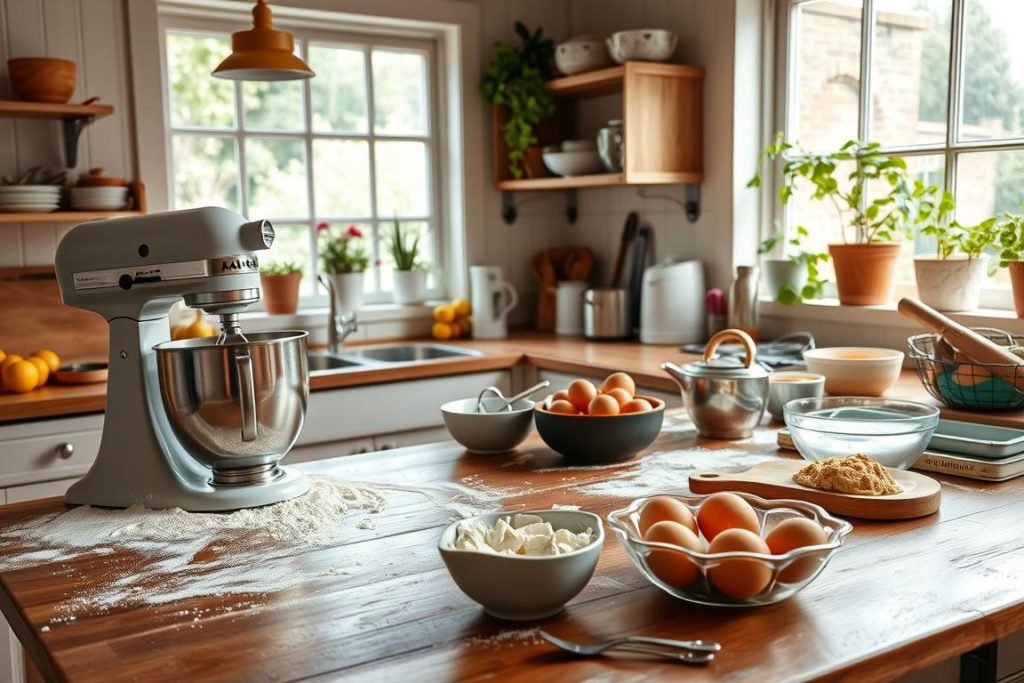
Always check your oven’s heat with a thermometer. Ovens can lie about their temperature. Use good pans and parchment paper too. Your bakes will cook evenly and won’t stick. Here’s how to make baking conditions even better:
- Use an ice cream scooper for same-sized cookies
- Grease cups for sticky stuff like honey
- Sift ingredients to avoid lumps
Avoiding Common Baking Mistakes
To get better at baking, avoid simple errors. Always follow the recipe closely. It’s a tested guide for great results. Measure everything right, especially dry stuff. A kitchen scale can help a lot.
| Tips | Benefits |
|---|---|
| Parchment paper usage | Prevent sticking; easy cleanup |
| Room temperature ingredients | Ensures smooth blending |
| Oven thermometer | Accurate heat distribution |
| Pre-measuring all ingredients | Efficient mixing and baking process |
Mix things just right, not too much. Overmixing makes things dense. Be gentle for the best cakes and breads. See every baking time as a chance to learn. Mistakes happen, but they help you get better and try new things.
Exploring Different Baking Styles
Whether you’re kneading dough or prepping for the perfect sponge, diving into various baking styles opens up a world of creativity and flavor. This section will guide you through the essentials of home bread baking and cake baking. It helps you master each craft with confidence.
Baking Bread at Home
Home bread baking starts with understanding the basics: flour, water, salt, and yeast. Using a digital kitchen scale can ensure your measurements are precise. This is crucial for the perfect loaf.
Bread flour, known for its high protein, is ideal for strong gluten networks. This gives your bread the ideal texture and elasticity. For those trying new recipes, whole wheat or specialty flours like rye can bring new flavors.
Here are some baking bread at home essentials:
- Flours: Different types yield different textures; from all-purpose to bread flour and specialty grains.
- Yeast: Active dry or instant, understanding its role and proper use is crucial.
- Mixing and kneading: These techniques are vital for gluten development.
- Proofing: This step is essential for a well-risen bread.
Cake Baking Essentials
Cake baking demands precision. Measuring ingredients and understanding mixing techniques are key. Techniques like creaming or folding impact the final product.
To guarantee success in cake baking, focus on:
- Accuracy in measurements: Essential for the chemical reactions that occur during baking.
- Mixing techniques: Whether it’s creaming butter and sugar or gently folding in egg whites, techniques matter.
- Oven thermometers: To ensure your oven is just the right temperature.
- Proper pan preparation: Parchment lining and correct greasing can prevent sticking.
Focusing on the distinct qualities and necessities of both baking styles enhances your skills. It also broadens your baking repertoire, making every session an opportunity for exploration and mastery.
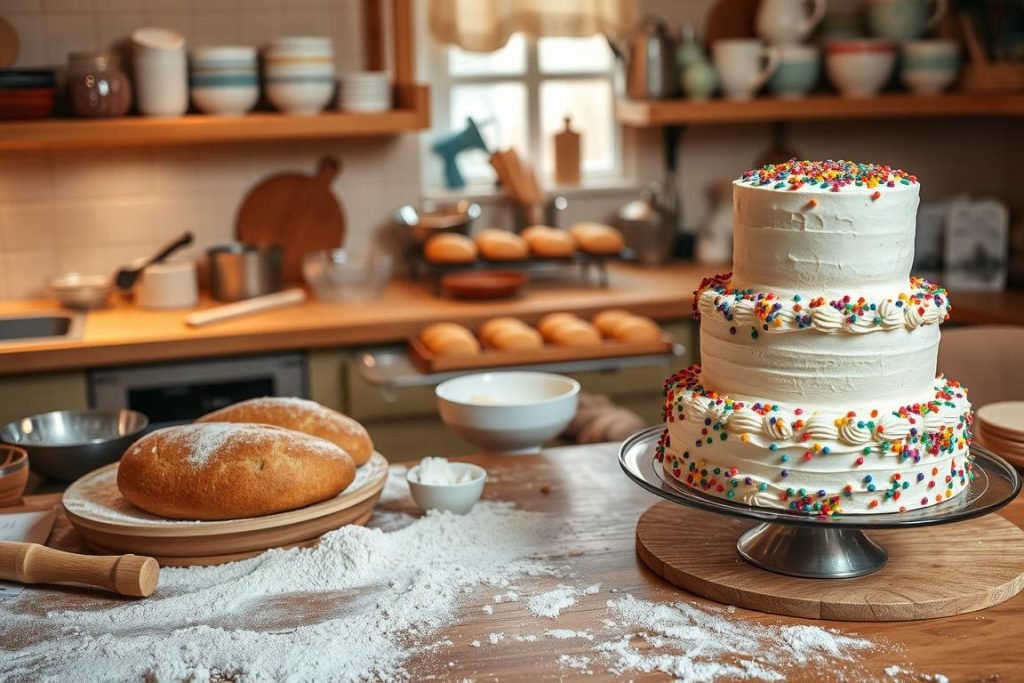
The journey into the aromatic world of baking styles—from rustic loaves to elegant cakes—will be a rewarding one. Harness the insights and techniques outlined here. Transform your baking adventures into a delightful blend of science and art.
Learning to Decorate Your Baked Goods
Starting your journey in cake decorating is exciting. You’ll learn how to use fondant decoration and buttercream techniques. These skills make your baked goods look and feel amazing. Decorating cakes makes the whole baking experience better.
Fondant vs. Buttercream
Fondant icing is smooth and perfect for detailed designs. It’s a key part of decorate baked goods. But, if you love a soft and tasty topping, choose buttercream. It works well for making everything from simple swirls to elaborate roses.
Simple Decorating Techniques
There are tools and tricks to help you decorate easily. A turntable and an offset spatula are great for buttercream. They make smoothing and decorating more precise.
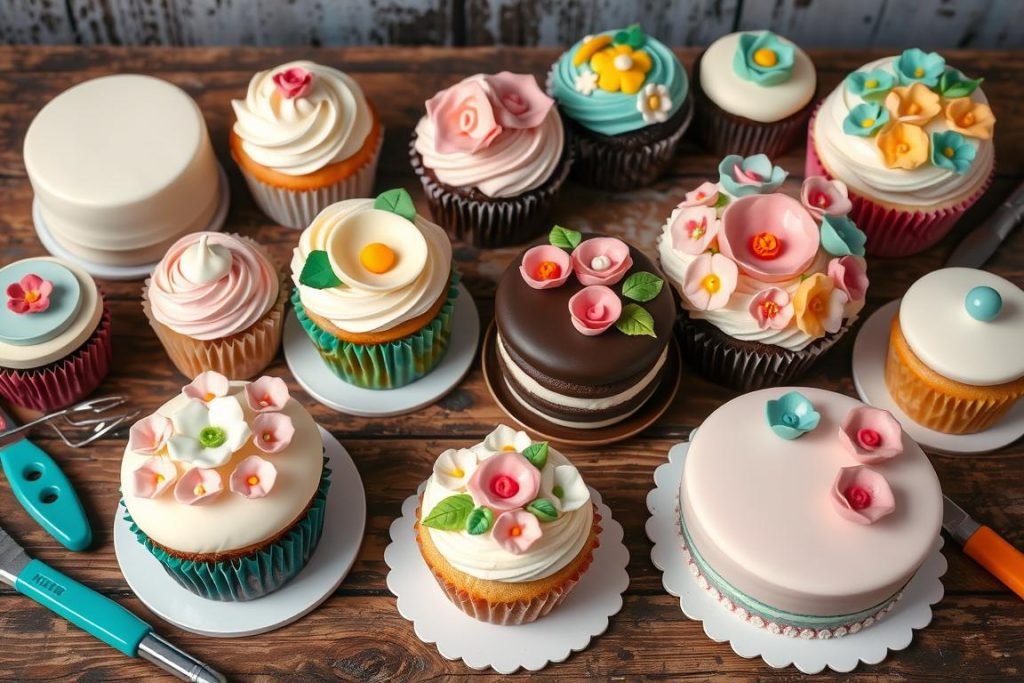
| Technique | Description | Tools Recommended | Tip for Beginners |
|---|---|---|---|
| Frosting Application | Smooth or textured appearance using buttercream. | Bench scraper, Offset spatula | Start with a crumb coat to lock in crumbs. |
| Piping Details | Create patterns or borders using a piping bag. | Wilton Tip 1M, Ateco 848 | Practice on a flat surface before applying to cakes. |
| Fondant Accents | Cover cakes or create shapes with rolled fondant. | Rolling pin, Fondant smoother | Keep fondant covered when not in use to prevent drying. |
| Naked Cake Style | Minimal outer layer of frosting for a rustic look. | Offset spatula, Bench scraper | Apply a thin layer of buttercream for the crumb coat. |
Improving your decorate baked goods skills is rewarding. Working with fondant decoration and buttercream techniques makes your creations more attractive. Start with simple tools and move to bigger projects as you get better.
Troubleshooting Common Baking Issues
Have you ever had a baking mishap? It happens to us all. Knowing how to fix these errors can really improve your baking. By learning to troubleshoot baking issues, you can make yummy treats every time. This includes solutions for flat cakes and fixing overbaked cookies.
Fixing Flat Cakes
Do your cakes sometimes come out flat? This can happen if leavening agents are old or measurements are off. Here’s what you can do:
- Test your baking powder or soda in vinegar or hot water. If it bubbles, it’s still good.
- Always measure ingredients carefully and mix as the recipe says.
- Use a thermometer to check your oven’s temperature. This helps cakes rise properly.
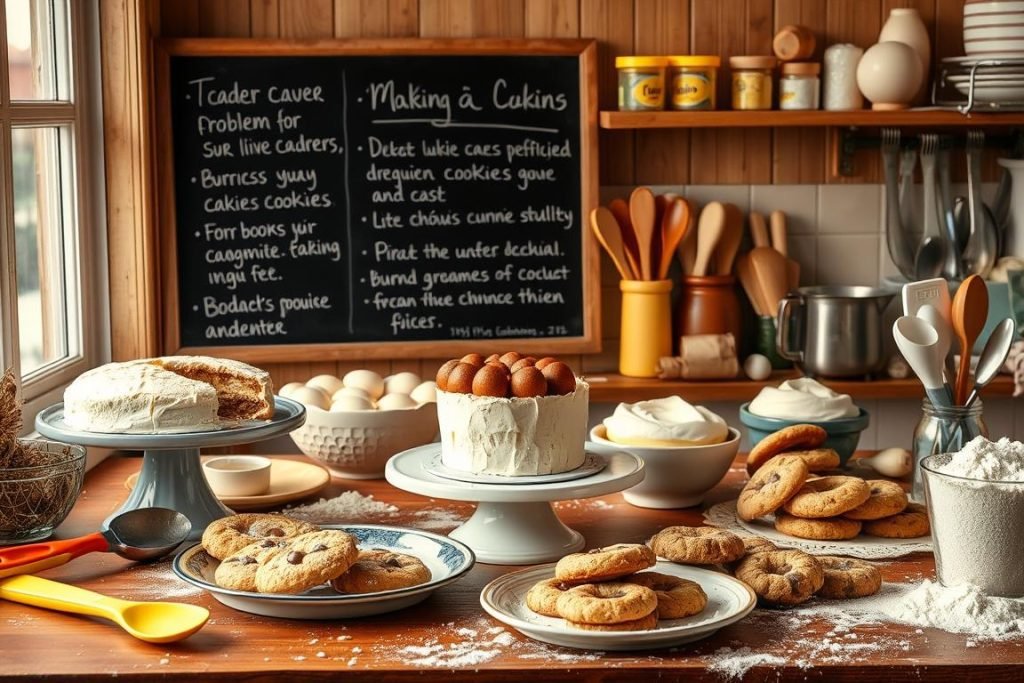
Dealing with Overbaked Cookies
Overbaked cookies can become too hard. But there are ways to keep them chewy. Try these steps:
- Use an oven thermometer to keep the temperature right.
- Check on cookies sooner than the recipe says. Then adjust the time.
- Bake cookies in the middle of your oven. Rotate the sheet if needed.
| Common Baking Issue | Potential Cause | Quick Fix |
|---|---|---|
| Flat Cakes | Inactive leavening agent | Test and replace if necessary |
| Overbaked Cookies | Incorrect oven temperature | Use an oven thermometer |
| Unevenly Baked Goods | Oven hot spots | Rotate baking sheets midway |
Baking mistakes can be a bummer, but don’t give up. With a little patience, you can turn failures into yummy treats. Remember these troubleshooting baking tips. They’ll help you prevent and fix issues, making your baking better than ever.
Enhancing Your Skills with Practice
Starting to better your baking skills takes more than just love for it. You need a good plan. Keeping a baking journal and joining a baking community can really help you grow.
Keeping a Baking Journal
Writing about your baking in a journal helps you see what works and what doesn’t. Write down your recipes, the changes you make, and how everything turns out. Doing this helps you pay close attention to small details.
It also becomes a personal guide showing how much you’ve learned. It’s a great way to slowly get better at baking.
Joining a Baking Community
One of the best steps you can take is to become part of a baking community. These groups are both in real life and online. They have forums, workshops, and events where bakers share ideas and help each other. Being part of a community not only makes you a better baker but also connects you with people who love baking as much as you do.
| Activity | Benefits | Tools |
|---|---|---|
| Maintaining a baking journal | Tracks progress, documents recipes and variations | Notebook, digital app |
| Participating in baking forums | Exchanges tips, receives feedback | Online platforms, social media groups |
| Attending baking workshops | Hands-on learning, professional guidance | Community centers, culinary schools |
As you learn more about baking, remember every baker started as a beginner. With hard work and helpful resources, getting better is possible. Keeping a journal and joining a baking group are key steps to improve. You not only boost your own skills but also add to the baking community’s rich history.
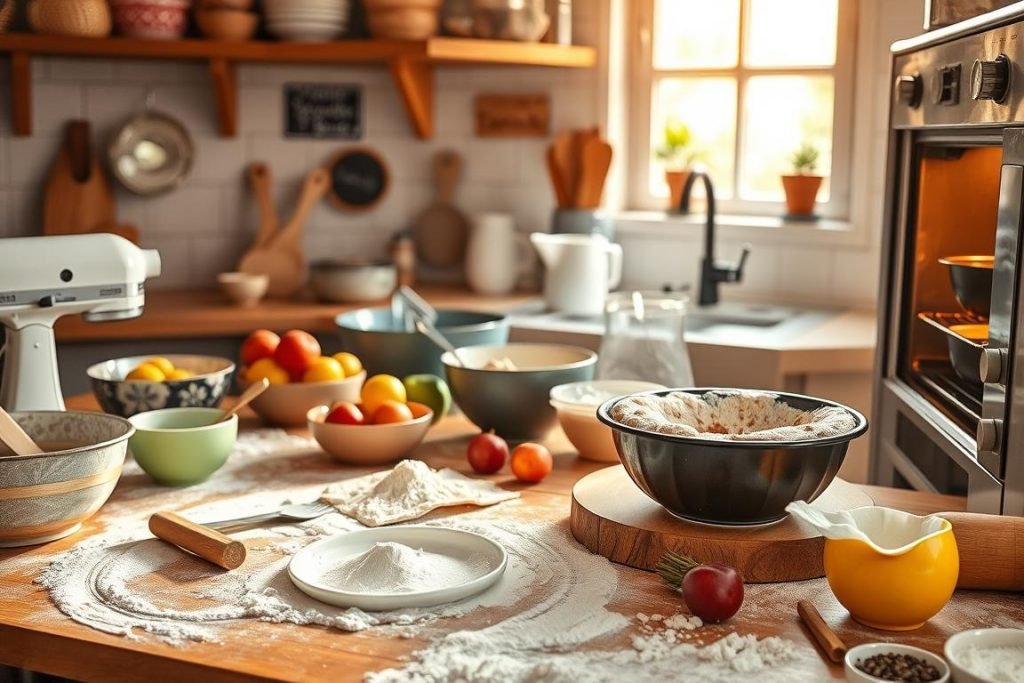
Resources for Further Learning
The journey of learning to bake is always ongoing. There are many resources to help improve your skills. Books like “The Cook’s Illustrated Baking Book” are great for learning. They teach you everything from measuring correctly to choosing the best ingredients.
Recommended Baking Books
Baking books are full of wisdom from experts. They give you advice you can come back to. They cover everything from the importance of room temperature ingredients to accurate oven temperatures. It’s also key not to switch out important ingredients like sugar and eggs.
Online Baking Classes and Tutorials
Now, you can also learn baking online. BBC Good Food offers a well-rated baking course with over 30 years of teaching. The course covers a wide range of techniques. It also allows you to connect with other baking lovers.
This online course is five weeks long. It teaches you everything from sponge cakes to meringues and brownies. All you need is an oven, some basic tools, and maybe an electric whisk.